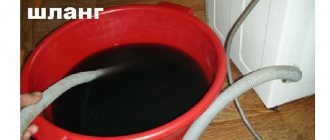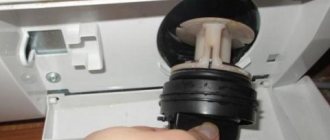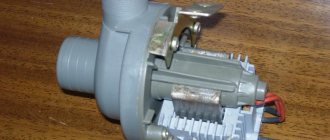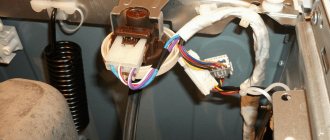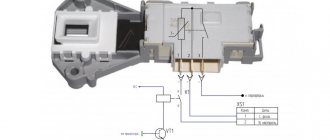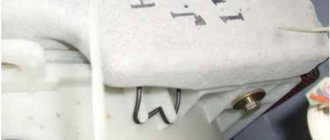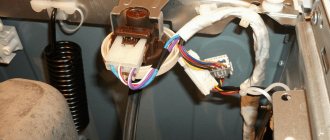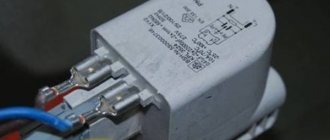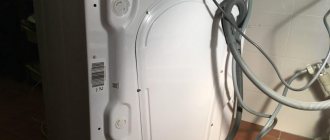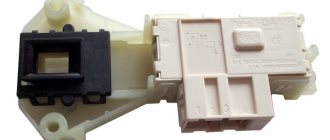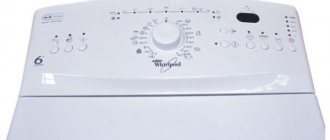Currently, a washing machine is an integral attribute in every apartment. Any housewife is interested in keeping her linens crystal clean. The quality of washing depends not only on the characteristics of the machine and powder, but also on the correct connection. The washing machine must not only pump clean water, but also ensure that waste water is discharged into the sewer system. As a rule, there are no problems with water injection. And illiterate organization of drainage can lead to a number of problems. Dirty water from sewer pipes can flow back into your car. To block the reverse flow of water, it is necessary to install a check valve on the drain hose of the washing machine, which is also called an anti-siphon.
Why do you need an antisiphon?
High-quality washing is impossible without an anti-siphon. Its main function is to pass dirty water into the sewer and prevent it from entering back. An anti-siphon is a small pipeline element with a tip for connecting to a hose and a built-in check valve. The diameters of the inlet and outlet pipes are different. Most often, this device is sold complete with a washing machine.
Anti-siphon valve
Without it, high-quality washing is only possible if certain operating conditions are met. The main condition is that the drain hose must be higher than the sewer pipes. Many people organize a drain right next to the floor in order to preserve the interior. This erroneous decision leads to an increase in the siphon effect. But even with a properly connected machine, problems can arise. If the sewer pipes have not been changed for a long time, a “siphon effect” also occurs when draining.
This is quite easy to determine. The operating time increases significantly, the quality of washing decreases, and energy costs increase. These are manifestations of the “siphon effect”. It appears if the drainage is not organized correctly. The diameter of the machine drain hose is much smaller than the diameter of the sewer pipe. Draining leads to a release of pressure, water is pumped out of the drum. The machine is forced to draw water from the water pipe and heat it. As a result, the operating time of the unit increases and water consumption increases. These problems can be avoided by installing a siphon with a check valve.
Methods for connecting a washing machine to the sewer
There are several ways to ensure water drainage:
- At each wash, secure the drain hose to the edge of the bathtub, sink or toilet.
- Connect to the siphon under the sink.
- Connect the drain to the sewer pipes under the bathtub.
In the first case, there is no need to permanently connect the hose. But with each wash, the ability to use one or another type of plumbing equipment will be limited, depending on where the hose is attached.
The second method is more practical. Its advantage is that the drain will be installed permanently, and access to the bathtub, toilet or sink will remain free. To connect, you need to purchase a special siphon with an outlet for the washing machine.
You may find this article useful on how to choose a heated towel rail. You can find out how to lay tiles in the bathroom here.
And this article will tell you how to choose a hot tub.
[rek_custom1]
Then simply connect the hose to the outlet in the siphon. This is good if the location of the unit allows this type of connection. If this is not possible, then you will have to focus on the third method - connecting to the sewer under the bathroom.
Operating principle of a check valve
A siphon with a check valve is mounted on the drain pipeline in an arbitrary location. When the drain program is turned on, the pump starts to pump out water. The pressure in the hose increases and water flows freely through the valve. After the drain cycle completes, the water stops flowing and the pressure drops. In this case, the device closes, blocking the passage. A tight connection is formed. In this way, the passage for water to enter the drum from the pipe is blocked. Due to the height difference between the inlet and outlet pipes, the reaction time to pressure changes is minimal.
The most commonly used locking device is:
- polypropylene ball;
- spring.
How the anti-siphon works
The locking mechanism is a small ball of air. When direct fluid pressure is removed, the ball rests against the sealing membrane. When back pressure occurs, the force of pressing the ball against the membrane only increases. Reverse penetration of liquid is not possible.
No ball cleaning required. Special ribs in the valve body serve for self-cleaning of the ball. A siphon with a spring valve uses a spring as the closing mechanism.
The design of the mechanism makes it possible to install it on any section of the pipeline. The installation location does not affect the quality of work.
All valve modifications are made of high-quality durable plastic. Therefore, the devices have a long service life. The service life can only be affected by water quality. Too hard water in the water supply system destroys the elements of the device.
When self-draining occurs
Even experienced craftsmen make mistakes during installation; they do not level the level correctly, resulting in self-draining of unused clean water. The machine is emptied and the liquid is drained into the sewer. The installation instructions for any device indicate that the outlet of the drain hole into the sewer is located at a height of 50 to 100 cm from the floor level.
The height of 50-60 cm exceeds the maximum permissible level in the drum. Self-draining occurs when the hose is installed lower, so the washing water is immediately removed into the sewer.
Bending the hose above the water level in the machine allows you to carry out a wash cycle and work out part of the program. Once the bleed pump is activated, water will move through the hose and a siphon effect will result.
Types of check valves
There are several types of antisiphons for washing machines:
- collapsible (segmental);
- non-separable;
- wall;
- mortise;
- washing
Types of antisiphons
Double check valve
Wall-mounted check valve
Demountable devices are best chosen for homes with hard water. If it gets dirty, it can be dismantled and disassembled. Without cleaning, the device can quickly fail. In addition, only such valves are suitable for certain brands of washing machines (for example, from the manufacturer LG). This is usually stated in the instructions for the washing machine. If the water is of good quality, a non-separable option is quite suitable. It is much cheaper than segment ones.
Non-separable valves are subject to forced replacement. Devices need to be checked and replaced more often with hard water.
Mortise devices are convenient to use when connecting a direct drain into a sewer pipe. To install the valve, a special mortise hole is prepared in the pipe. This connection option is somewhat more complicated.
Wall-mounted ones have the most aesthetic appearance. But they are significantly more expensive than others. It is mounted between the washing machine and the wall. This is the most compact device.
Wall check valve
The washer is not suitable for washing machines. Their purpose is a sink siphon. There are also many models with decorative inserts. Inserts are usually made of high quality stainless steel. But such models are several times more expensive. But it should be remembered that appearance does not affect quality.
There are no special rules when choosing an antisiphon. The main thing is that the device fits the washing machine and the drainage structure. Therefore, first of all, you need to carefully study the machine’s instructions and the design features of the sewer pipes.
Features of use
- Some manufacturers of household appliances add a check valve to the basic configuration of washing machines, but not all do this. Therefore, most likely, you will have to purchase this device yourself in a specialized store.
- If you connect the drain using a check valve, then you do not have to worry about following the recommendations regarding the height of the drain hose. The main thing is to install all elements of the system in such a way that they can be easily accessed in case cleaning or repairs are needed.
- When purchasing a check valve, be prepared for the fact that this device will have to be replaced every few years, as it will be exposed to hard tap water. The better the quality of the product, the longer it will last, but you still shouldn’t overpay - no matter how expensive the device is, sooner or later it will need to be replaced.
Related article: DIY New Year's gifts for 2021: 20 simple and cozy ideas (35 photos)
DIY installation
Installing the device is not particularly difficult. The installation principle for all varieties is approximately the same:
- connect the siphon to the valve tube (for mortise ones - install it in a pre-prepared cutout in the pipe);
- connect the second output to the drain hose of the washing machine;
- seal all joints with sealant.
Antisiphon tubes have different diameters. Therefore, incorrect connection is completely excluded. The most important thing is to ensure the tightness of all connections.
It must be remembered that in drain mode there is strong vibration of the hose. High-quality connections will help avoid leaks. Before starting, it is necessary to check the operation of the sewer system. If water flow is poor, the pipes need to be cleaned.
Which manufacturers are better
Check valves for washing machines can be purchased at any hardware store. The variety of manufacturers and price range is quite wide. To ensure that the device works for a long time, when purchasing, it is better to give preference to trusted suppliers. The table shows the most common devices from well-known brands.
| Manufacturer | Type | Characteristics |
| Alcaplast, Czech Republic | APS2 | Plastic, ? 32 mm, for any hoses, one-piece |
| Siroflex, Italy | 012677 | Mortise, spring. |
| Merloni, Italy | 95101800 | Mortise, plastic |
| McALPINE, Scotland | WMV-32WH | Plastic, ? 19-25×32, one-piece |
| ANI Plast | P-12/M500/APS2 | Minisiphon (wall-mounted) |
Whether or not to install a siphon with a check valve is up to everyone to decide for themselves. But you should remember that without it it is impossible to organize a drain. The quality of washing decreases, washing time, water and electricity consumption increases. An inexpensive device that is easy to install even without the involvement of specialists will help avoid these problems.
Recommendations from experts
Antisiphons are sold in every hardware store with a wide range of prices. For long-term operation of the device, it is better to use trusted manufacturers.
- Non-return drain valve for a washing machine, made in Italy - “Siroflex” . Made of polypropylene, type – mortise. Installation is carried out in a sewer pipe and a drain hose is attached. It is a stainless steel spring device with a rubber membrane. Effectively protects the drainage system.
- The wall valve from Alcaplast – Czech Republic has also proven itself to be excellent. It is distinguished by quality, availability in the price range and functionality. Suitable for any drain hose. Reliably copes with waste water from the washing machine. Installed as an end mount with a sewer pipe. Consists of a spring mechanism, a reflector and a mounting point.
- Another high-quality polypropylene check valve from the Italian manufacturer “Merloni” . Installed and mounted under the sink for easy cleaning. This is a spring with a rubber membrane.
- Scotch valve “McALPINE” .
- Wall-mounted mini-siphon ANI Plast .
